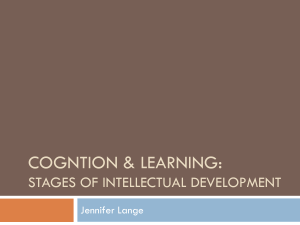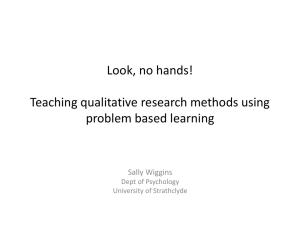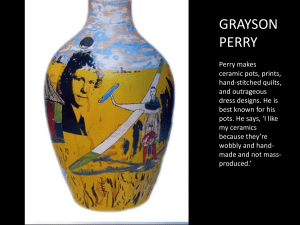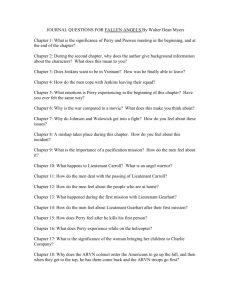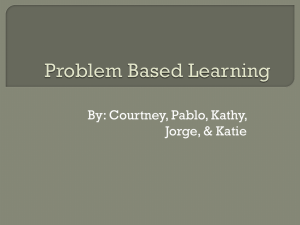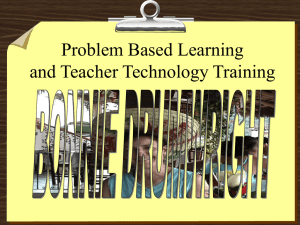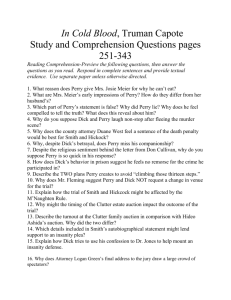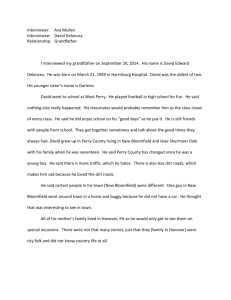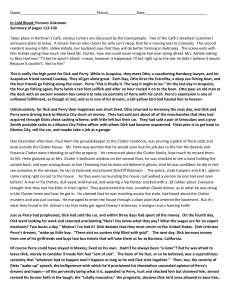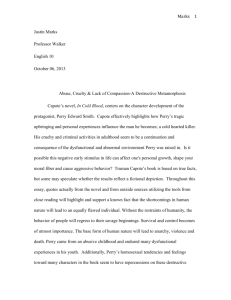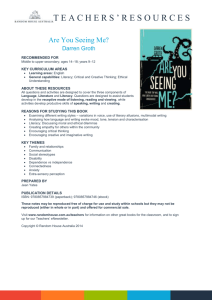The Perry Model of Intellectual and Ethical Development
advertisement
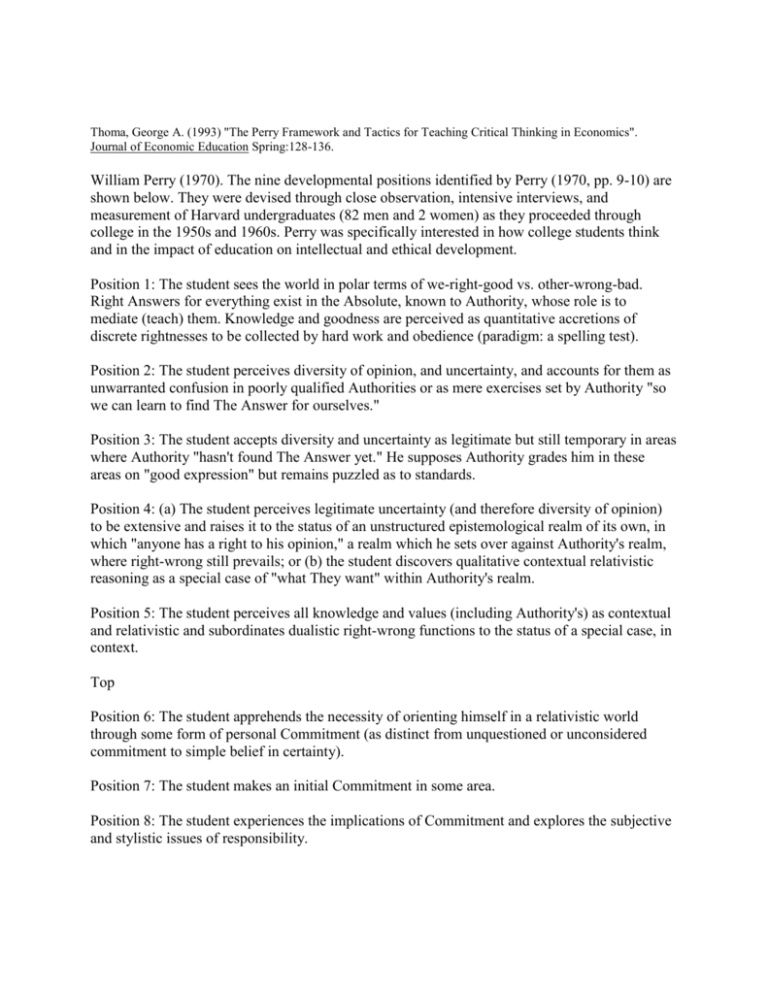
Thoma, George A. (1993) "The Perry Framework and Tactics for Teaching Critical Thinking in Economics". Journal of Economic Education Spring:128-136. William Perry (1970). The nine developmental positions identified by Perry (1970, pp. 9-10) are shown below. They were devised through close observation, intensive interviews, and measurement of Harvard undergraduates (82 men and 2 women) as they proceeded through college in the 1950s and 1960s. Perry was specifically interested in how college students think and in the impact of education on intellectual and ethical development. Position 1: The student sees the world in polar terms of we-right-good vs. other-wrong-bad. Right Answers for everything exist in the Absolute, known to Authority, whose role is to mediate (teach) them. Knowledge and goodness are perceived as quantitative accretions of discrete rightnesses to be collected by hard work and obedience (paradigm: a spelling test). Position 2: The student perceives diversity of opinion, and uncertainty, and accounts for them as unwarranted confusion in poorly qualified Authorities or as mere exercises set by Authority "so we can learn to find The Answer for ourselves." Position 3: The student accepts diversity and uncertainty as legitimate but still temporary in areas where Authority "hasn't found The Answer yet." He supposes Authority grades him in these areas on "good expression" but remains puzzled as to standards. Position 4: (a) The student perceives legitimate uncertainty (and therefore diversity of opinion) to be extensive and raises it to the status of an unstructured epistemological realm of its own, in which "anyone has a right to his opinion," a realm which he sets over against Authority's realm, where right-wrong still prevails; or (b) the student discovers qualitative contextual relativistic reasoning as a special case of "what They want" within Authority's realm. Position 5: The student perceives all knowledge and values (including Authority's) as contextual and relativistic and subordinates dualistic right-wrong functions to the status of a special case, in context. Top Position 6: The student apprehends the necessity of orienting himself in a relativistic world through some form of personal Commitment (as distinct from unquestioned or unconsidered commitment to simple belief in certainty). Position 7: The student makes an initial Commitment in some area. Position 8: The student experiences the implications of Commitment and explores the subjective and stylistic issues of responsibility. Position 9: The student experiences the affirmation of identity among multiple responsibilities and realizes Commitment as an ongoing, unfolding activity through which he expresses his life style. Perry's model moves from perceiving the world in absolutist terms (positions 1,2,3) to making more room for diversity and recognizing the problematic nature of life (positions 4,5,6,) to finding one's own place through personal commitment in a relativistic world (positions 7,8,9). In brief, development moves through sequences - from simplicity to complexity and from differentiation to integration. In Perry's scheme, the immature person perceives the world in either-or, good-bad, permitted-not permitted terms. A child or an immature adult looks to an outside authority - parent or teacher- for the "right" answer. Gradually, he begins to discover that authorities disagree and that the values of fellow students differ from his own. In an effort to resolve the differences between equally credible people, he adopts the "everyone has a right to his own opinion" stance or the "I'll do what they want even thought I don't see why" attitude. The individual attaining more advanced levels of development begins to see that he must find integrity for himself in a relativistic world, identifying the things that are important and central to his sense of self. In his research, Perry found that most Harvard freshmen enter college at stages 3, 4 and 5 and graduate in positions 6,7, and 8. Position 9 was rarely observed in college students, but I would expect it to be more common among adult learners, especially those engaged in substantial intellectual work. Indeed, as research extends to the adult years, I would expect revision and extension of Perry's top three or four positions. It is, of course, possible that the highest positions of intellectual development reported by Perry for Harvard undergraduates would also be the highest positions among adults, but that seems unlikely. As we saw in the early pages of this chapter, IQ was once thought to parallel physical growth, rising to a maximum when physical maturity is attained, declining as old age is approached. Further investigation of intellectual performance on intelligence tests revealed not so much different amounts of intelligence between youth and old age as different patterns, as represented in the concepts of fluid and crystallized intelligence. Similarly, I would expect new patterns and new developmental positions to appear among adults doing extensive intellectual work. The promise of further study of developmental theories of intellectual growth lies in their potential to illuminate the range and sequence of patterns of human learning. If we know where an adult stands in intellectual development, we are in a better position to help him or her advance to the next stage. From: Cross, Kathryn Patricia Adults as Learners. The Perry Model of Intellectual and Ethical Development Stages of Cognitive Development Students generally believe knowledge is certain and unambiguous: black/white, right/wrong Questions have immutable, objective answers Students generally believe authorities possess valuable wisdom that contains eternal truths #2: Multiplicity Students come to believe that where uncertainty exists, knowledge and truth are essentially subjective and personal #3: ContextualRelativism Students come to believe that even where uncertainty exists, people must make choices about premises, frameworks, hypotheses, and theories to apply; policy conclusions are not selfevident #4: ContextAppropriate Decisions Students may come to acknowledge that choices require analysis and values. Knowledge, theories, and methods are imperfect and uncertain, thus personal choices require acknowledging personal responsibility #1: Dualistic Thinking Transitions in Cognitive Development Certainty yields to uncertainty and ambiguity Students come to recognize that mere opinion is insufficient because specific critieria help evaluate the usefulness and validity of knowledge claims: • methodology • empirical evidence • explanatory power • predictive power • logical consistency • positive vs. normative conclusions Students may come to recognize that even in a world of uncertainty, they must make choices (whether about ideas, hypotheses, theories, or policies). These choices require methods of critical thinking. that follows from personal values. Source: model modifications by Nelson (1989), with additional comments by Thoma (1993) Definition Problem-based learning (PBL) is a total approach to education. As defined by Dr. Howard Barrows and Ann Kelson of Southern Illinois University School of Medicine, PBL is both a curriculum and a process. The curriculum consists of carefully selected and designed problems that demand from the learner acquisition of critical knowledge, problem solving proficiency, self-directed learning strategies, and team participation skills. The process replicates the commonly used systemic approach to resolving problems or meeting challenges that are encountered in life and career. Role Changes In problem-based learning, the traditional teacher and student roles change. The students assume increasing responsibility for their learning, giving them more motivation and more feelings of accomplishment, setting the pattern for them to become successful life-long learners. The faculty in turn become resources, tutors, and evaluators, guiding the students in their problem solving efforts. History Problem-based learning began at McMaster University Medical School over 25 years ago. It has since been implemented in various undergraduate and graduate programs around the world. Additionally, elementary and secondary schools have adopted PBL. The PBL approach is now being used in a few community colleges as well. Results Students involved in problem-based learning acquire knowledge and become proficient in problem solving, self-directed learning, and team participation. Studies show that PBL prepares students as well as traditional methods. PBL students do as well as their counterparts from traditional classrooms on national exams, but are in fact better practitioners of their professions.
